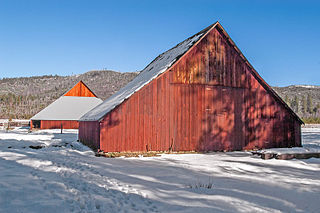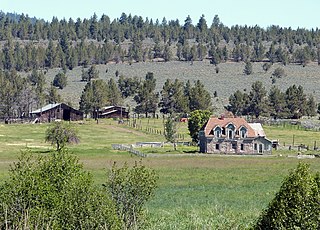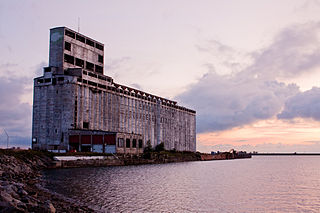Wood shingles are thin, tapered pieces of wood primarily used to cover roofs and walls of buildings to protect them from the weather. Historically shingles were split from straight grained, knot free bolts of wood. Today shingles are mostly made by being cut which distinguishes them from shakes which are made by being split out of a bolt.

The Hollywood Woman's Club is a historic woman's club, located at 501 North 14th Avenue, in Hollywood, Florida. On February 10, 1995, it was added to the U.S. National Register of Historic Places.

The Amos Kling House is a historic house located at 220-222 Magnolia Avenue in Daytona Beach, Florida. It is locally significant for its association with the development of the resort community of Daytona Beach during the early 20th century.

The Old Faithful Historic District in Yellowstone National Park comprises the built-up portion of the Upper Geyser Basin surrounding the Old Faithful Inn and Old Faithful Geyser. It includes the Old Faithful Inn, designed by Robert Reamer and itself a National Historic Landmark, the upper and lower Hamilton's Stores, the Old Faithful Lodge, designed by Gilbert Stanley Underwood, the Old Faithful Snow Lodge, and a variety of supporting buildings. The Old Faithful Historic District itself lies on the 140-mile Grand Loop Road Historic District.

Freetown Rosenwald School is a historic Rosenwald school building in the historic African American community of Freetown at Glen Burnie, Anne Arundel County, Maryland. It is a simple, one-story, gable-roofed, rectangular frame building. The exterior walls are sheathed in aluminum siding and the gable roof is covered with asphalt shingles and displays minimal overhang. It was built in 1924-25, by the school construction program of the Julius Rosenwald Fund, to serve the local African American community. It is one of ten Rosenwald Schools surviving in Anne Arundel County.

The Edisen Fishery is a fishery located in Rock Harbor in the Isle Royale National Park in Michigan. It was designated a Michigan State Historic Site in 1976 and listed on the National Register of Historic Places in 1977.

The Gifford–Walker Farm, also known as the Alice Walker Farm, is located on North Bergen Road in North Bergen, New York, United States. Its farmhouse is a two-story Carpenter Gothic style structure built in 1870.

The Unity Ranger Station is a United States Forest Service compound consisting of five buildings and a lookout tower in the Wallowa-Whitman National Forest of northeastern Oregon. For many years, it was the administrative headquarters for the Unity Ranger District. It is located in the small unincorporated community of Unity, Oregon. The historic structures were built in the rustic style by the Civilian Conservation Corps between 1936 and 1938. Today, the ranger station is only used during the summer months to house Forest Service fire crews. The ranger station is listed on the National Register of Historic Places.

The John J. Michels House is a private house located at 1121 E. Houghton Avenue in Houghton, Michigan. It was designated a Michigan State Historic Site in 1989 and placed on the National Register of Historic Places in 1991.

The McCauley and Meyer Barns in Yosemite National Park are the last barns in the park that retain their original characteristics as structures built by homesteaders. The McCauley barn and the two Meyer barns represent different construction techniques and styles of design.

The El Tovar Stables at the south rim of the Grand Canyon were built about 1904, at the same time the nearby El Tovar Hotel was built, to house the animals used in general transportation around the park. Collectively called the "transportation department" in the early 20th century, the three structures comprised a horse barn or stable, a mule barn and a blacksmith shop.

Jackson Park Town Site Addition Brick Row is a group of three historic houses and two frame garages located on the west side of the 300 block of South Third Street in Lander, Wyoming. Two of the homes were built in 1917, and the third in 1919. The properties were added to the National Register of Historic Places on February 27, 2003.

The Roba Ranch is a pioneer ranch located near the small unincorporated community of Paulina in Crook County, Oregon. The ranch is named for George and Mary Roba, sheep ranchers who acquired the property in 1892. Most of the important ranch buildings were constructed by the Roba family between about 1892 and 1910. Today, the ranch covers 1,480 acres (6.0 km2) and is privately owned. The ranch was listed on the National Register of Historic Places in 2007.

The Ellice School is a historic two-room schoolhouse at 185 Pleasant Street in Millis, Massachusetts. The single story wood frame Greek Revival building was constructed c. 1849, when Millis was still part of Medway. It is sheathed in wood shingles, with wood trim, including corner pilasters. Its gable roof is clad in asphalt shingles. The building served as a public school until 1931. It was used during the Great Depression and the Second World War for community activities, but has stood vacant since then. It is the only remaining district school building in Millis.

The Colcord Farmstead, now Longmeadows Farm, is an historic farm property at 184 Unity Road in Benton, Maine, USA. With a development origin in 1786, it is recognized architecturally for its farmstead complex, a fine example of late 19th-century agricultural architecture. It was added to the National Register of Historic Places on December 29, 2005.

The Sutton Community Hall is a historic municipal building in Sutton, Alaska. It is located on the west side of Jonesville Road, about 0.25 miles (0.40 km) north of its junction with the Glenn Highway. It is a single-story wood frame structure, measuring 40 by 70 feet, with a shallow-pitch gabled sheet metal roof. The building has entrances on the north, south and east sides, the east-facing one sheltered by a hood with diagonal bracing. The exterior has several types of cladding, including asphalt shingles and board-and-batten siding. The building was built in 1927 to serve as a bunkhouse for workers building the Eklutna Power Plant, and was moved to the present location in 1950 to serve the unincorporated community of Sutton as a meeting space. The hall served the community as its principal civic and social meeting space for forty years.

The Dr. B.J. Kendall Company is a historic industrial facility at 228 North Main Street in th Enosburg Falls village of Enosburgh, Vermont. Built in 1880, it was for many years the site where "Kendall's Spavin Cure", a treatment for a horse ailment, was manufactured and marketed. This business was one of the town's economic successes, its owners contributing significantly to its architectural heritage. The building was listed on the National Register of Historic Places in 1993; it presently (2016) stands vacant.

The Sandenburgh-Rogers Summer Resort Complex, also known as the Interlochen Cottage, is a private summer home located at 2046 Crescent Beach Road in Williamsport, Michigan. It was listed on the National Register of Historic Places in 1996.

The Charles Palmer House is a single-family home located at 240 North Main Street in Imlay City, Michigan. It was listed on the National Register of Historic Places in 1987.

The Eli and Sidney Teeter Albertson House is a single family home located at 4480 Sheldon Road in Oakland Charter Township, Michigan. It is a rare Victorian example of an I-house in Oakland Township. It was listed on the National Register of Historic Places in 2002.

























